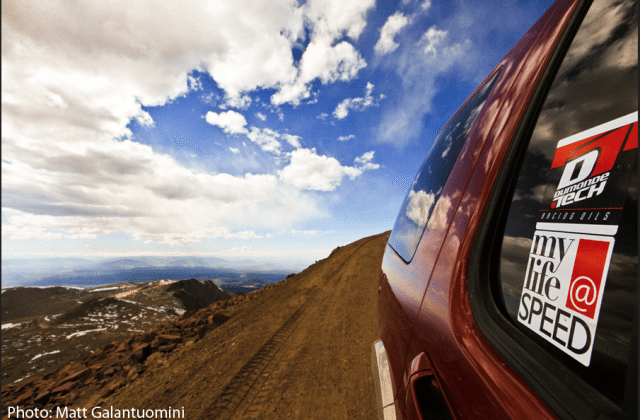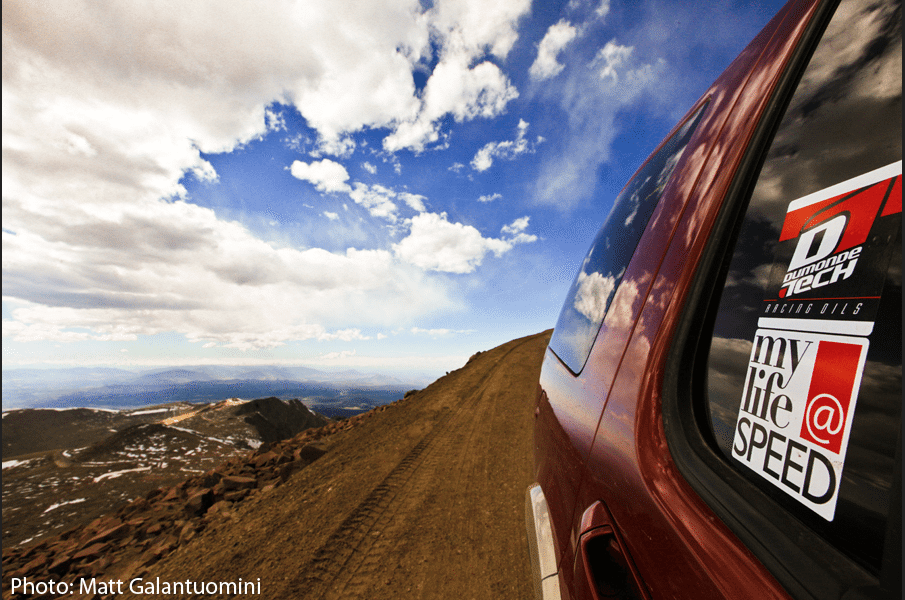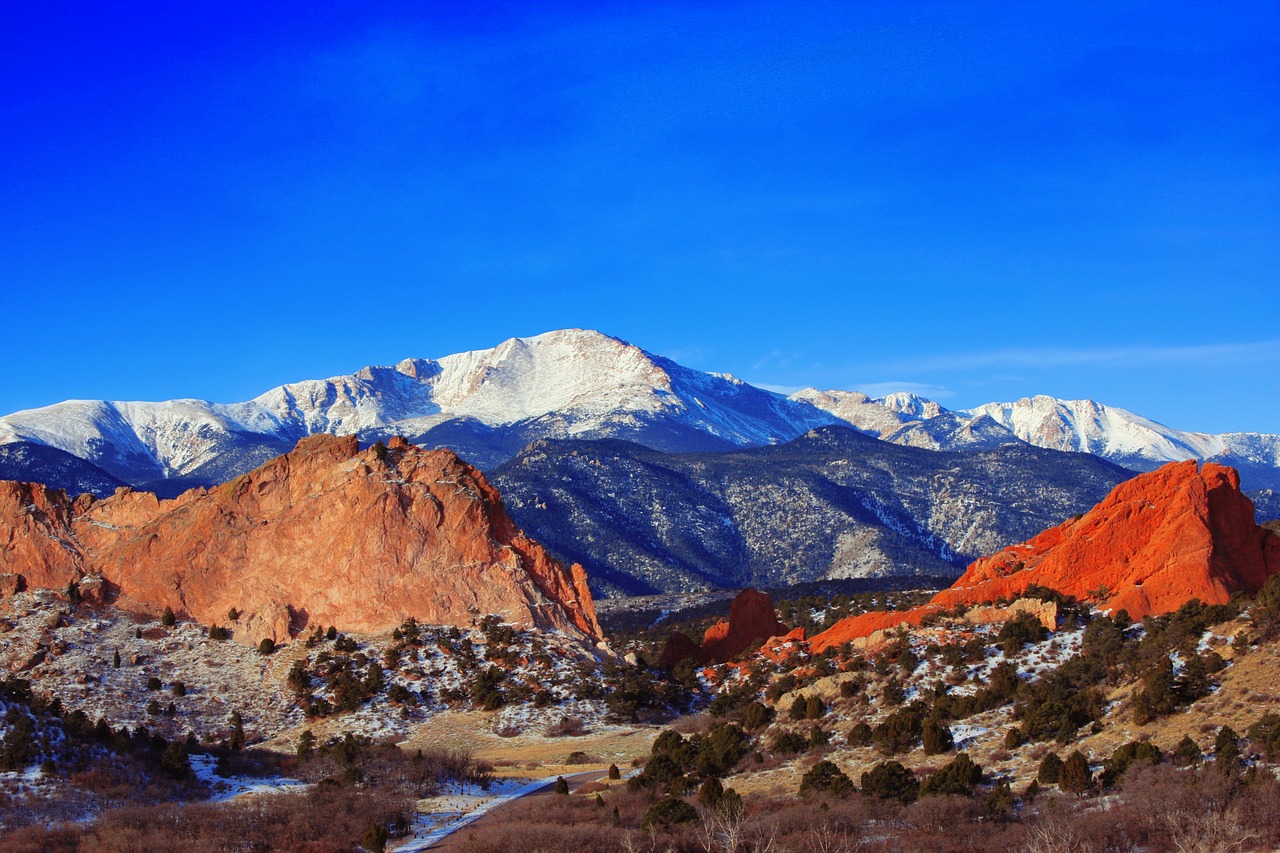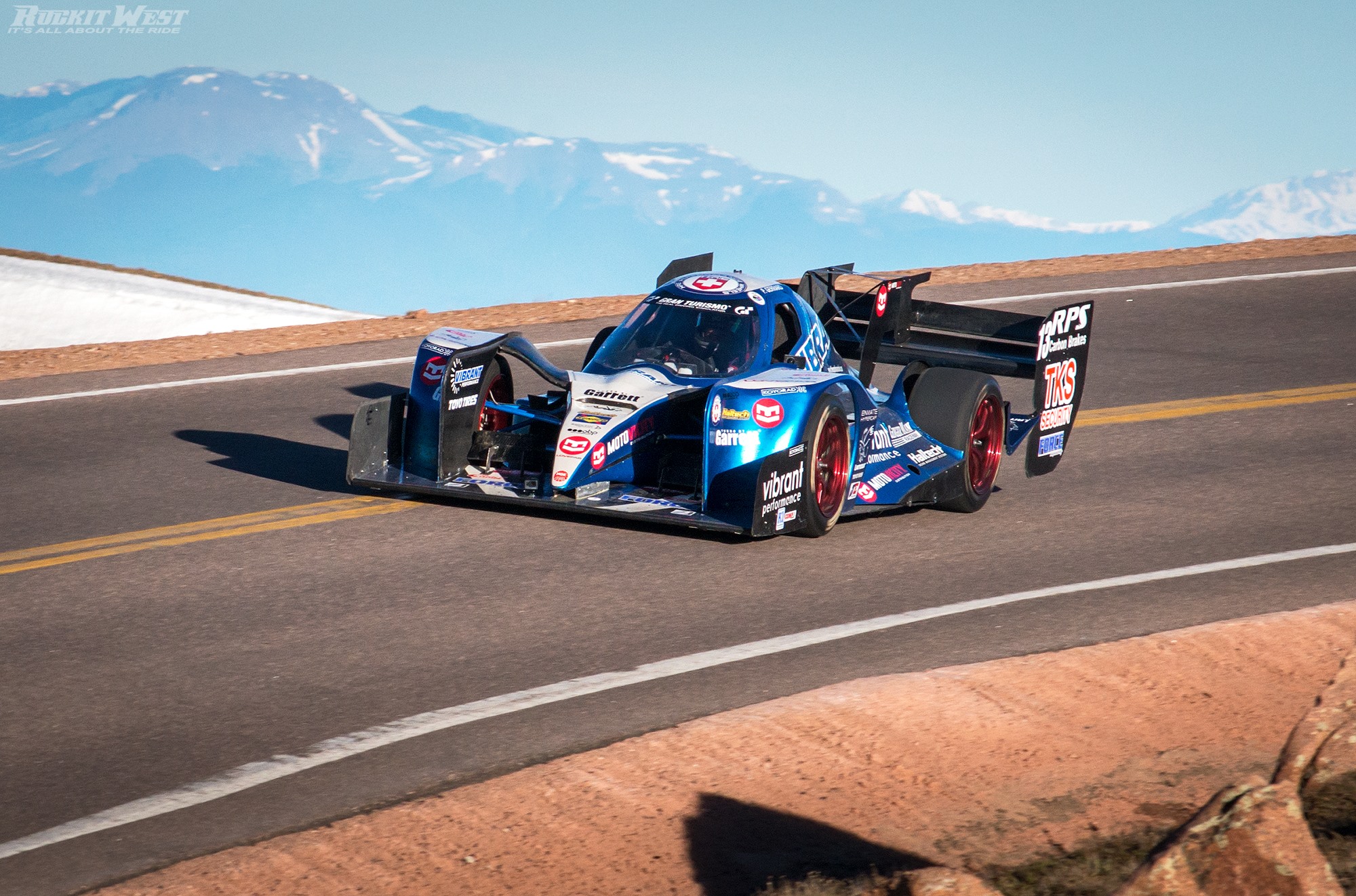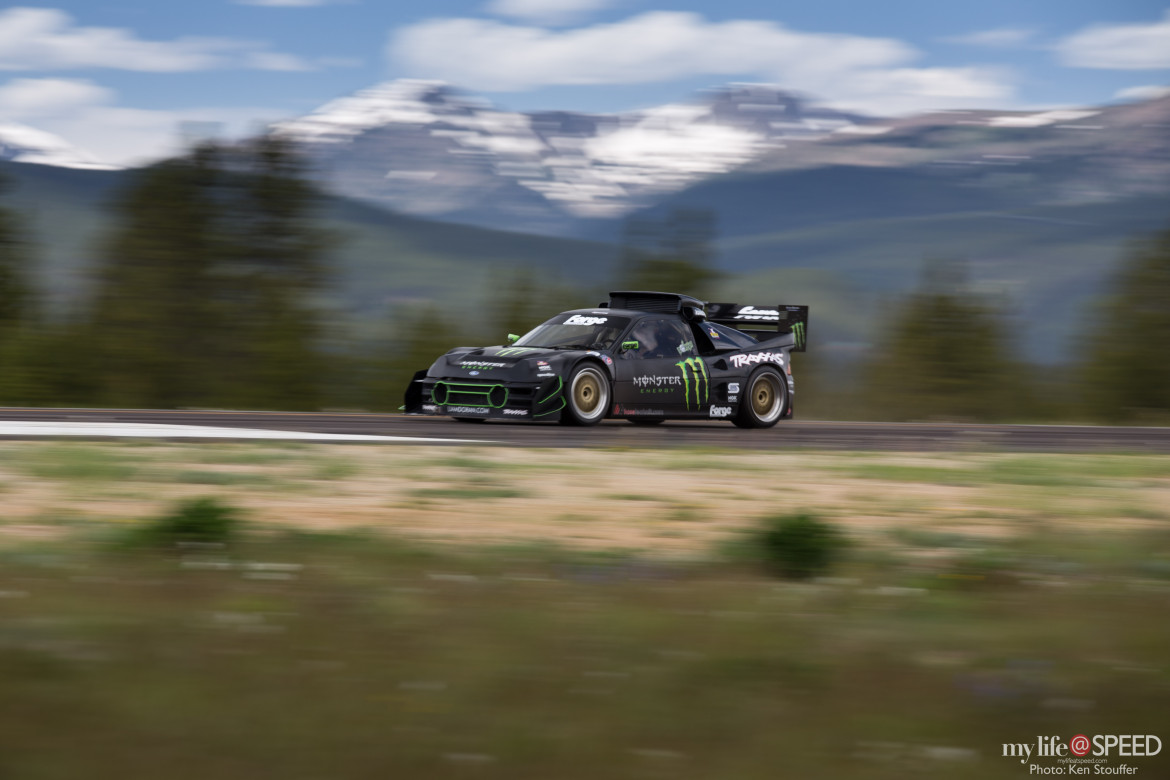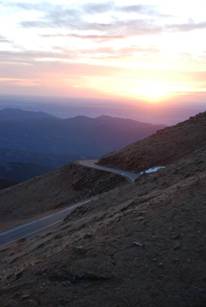 Commissioned by Thomas Jefferson to explore the Great Plains, Lt. Zebulon Pike first saw Pikes Peak in 1806 from the eastern portion of today’s Colorado in 1806. As he approached the magnificent peak, rising abruptly from the plains, Pike swore this 14,110-foot mountain would never be conquered by man.
Commissioned by Thomas Jefferson to explore the Great Plains, Lt. Zebulon Pike first saw Pikes Peak in 1806 from the eastern portion of today’s Colorado in 1806. As he approached the magnificent peak, rising abruptly from the plains, Pike swore this 14,110-foot mountain would never be conquered by man.
Zebulon Pike never scaled the mountain which bears his name. But today, Pikes Peak has been climbed by tourists from all over the world in cars, on horseback, on foot, on motorcycle and bicycle. Most visitors are overcome by its beauty, including Katherine Lee Bates, who was inspired by the view from the summit to compose America the Beautiful in 1893.
Pike could have imagined neither motorcars nor the automobile race course which would conclude at the summit of his peak a little over a century after his first sighting. By 1900, a carriage road had been built. On August 12, 1901, two Denver men named Yont and Felker were the first to drive to the top. Their trip in a two-cylinder Locomobile Steamer took just over nine hours and was accomplished by pushing as well as driving their motorcar.
Spencer Penrose, one of Colorado Springs’ city’s major benefactors, realized the tourist potential of such a beautiful landmark. In 1915, Penrose finished converting the narrow carriage road into the Pikes Peak Highway. In order to publicize his adopted hometown and his new road he devised a simple plan; run an automobile race to the summit of Pikes Peak on the new highway.
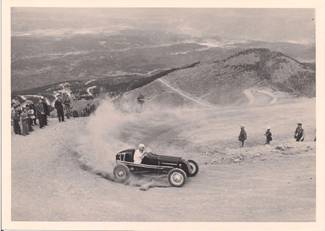 The Pikes Peak Auto Hill Climb was first held on August 10, 11, and 12, 1916. Through the years, the road was widened and some sections paved. It is now fully-paved after work was completed in 2011, and this summer’s race will be the first on all asphalt for the competitors.
The Pikes Peak Auto Hill Climb was first held on August 10, 11, and 12, 1916. Through the years, the road was widened and some sections paved. It is now fully-paved after work was completed in 2011, and this summer’s race will be the first on all asphalt for the competitors.
Besides the now-completed paving, the course and race format have not changed significantly from the original. Drivers and cars came from all over the world to compete in one of the most grueling courses known to the world of racing.
Drivers, then and now, are challenged by the torturous road and the rapidly changing weather. Starting out in sunshine, the driver could travel through sleet, thunderstorms, wind, hail, fog, or blinding snow before finishing, causing this breathtaking event to be called “The Race to the Clouds.”
The first Pikes Peak Champion was 22-year old Rea Lentz from Washington. His Romano Demon Special was the smallest car entered and he was the youngest driver. His time was 20 minutes, 55.6 seconds. After his win, he was never heard from again by anyone associated with the race.
Among those entered in that first-ever event was crowd-pleaser Barney Oldfield. He drove a big Delage, and while he did not distinguish himself among the top drivers, spectators came to watch this famous man attack the Peak. Eddie Rickenbacker, later to become famous as a World War I flying ace, was also registered to drive. Duesenberg automobiles were driven, as were Cadillacs, Hudsons and a Stutz. Entry fees were $25 to $50, depending on the event. First Prizes ranged from $500 to $2,000 cash, again depending upon which event the driver entered. To further encourage competition, Penrose offered a 43-inch trophy covered in Colorado silver and gold, valued at $10,000. The winners could keep the trophy for a year.
 Motorcycles were important in August of 1916. One of the most popular models was the Excelsior motorcycle. Built by Ignaz Schwinn, these cycles were ridden by 19 out of the 29 entrants. Schwinn, in partnership with his son Frank, later produced the famous “Schwinn-built” bicycles.
Motorcycles were important in August of 1916. One of the most popular models was the Excelsior motorcycle. Built by Ignaz Schwinn, these cycles were ridden by 19 out of the 29 entrants. Schwinn, in partnership with his son Frank, later produced the famous “Schwinn-built” bicycles.
In recent years, the motorcycle divisions have grown in stature and popularity. Davey Durelle of Elizabeth, Colorado, has won 14 times on the mountain. Brothers Greg Tracy and Gary Trachy have won 13 titles on their bikes alone. Ducati’s Carlin Dunne set the course mark of 11:11.329 last summer in the loaded 1205 Division.
In the early races mechanics rode with drivers. Their presence was necessary due to the many mechanical malfunctions and breakdowns, which happened on this near-wilderness route. Today’s drivers fervently wish they could have mechanics at their side, for the ever-present mechanical and technical problems which are a part of this unique event. Initially, it may not have been specified that the driver must stay on the road, for there are accounts of short-cuts over the rough terrain.
While this first event was successful by all counts, war disrupted the continuity of the Pikes Peak Hill Climb; it was not held again until 1920. The 1920 race emerged sanctioned by the American Automobile Association (AAA), and was won by Otto Loesche, of Indy 500 fame. He repeated his victory in 1924. Glen Schultz was one of the premier hill climb drivers of the era. He captured seven Open Wheel Division titles: 1923, 1926, 1927, 1928, 1930, 1932, and 1933. He also won the Stock Car Division in 1929.
These early racers all drove Open Wheel cars. The Stock Car Division was added in 1929. This now famous class caused hot competition from a different breed of drivers, but unfortunately was dropped in 1935; it resumed again in 1956.
The list of champions includes famed competitors like Louis Unser, Al Rogers, Bobby Unser, Mario Andretti, Roger Mears, Al Unser, Wally and Paul Dallenbach, Eddie Mulder and Bobby Donner.
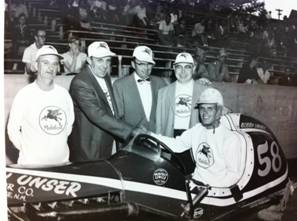 The Unser family, still the winning-est family in Pikes Peak history, began racing up the hill in 1926. The three brothers, Louis, Jerry and Joe, had been the first to take a motorcycle with sidecar to the summit. Always a bridesmaid in the early years, Joe was consistently second. His brother Jerry competed in 1931. But in 1930 another brother participated in his first Race to the Clouds. Beginning in 1934 Louis won his first championship, and competed over and over until his last race at the age of 70. In his 71st year he returned once again as a mechanic.
The Unser family, still the winning-est family in Pikes Peak history, began racing up the hill in 1926. The three brothers, Louis, Jerry and Joe, had been the first to take a motorcycle with sidecar to the summit. Always a bridesmaid in the early years, Joe was consistently second. His brother Jerry competed in 1931. But in 1930 another brother participated in his first Race to the Clouds. Beginning in 1934 Louis won his first championship, and competed over and over until his last race at the age of 70. In his 71st year he returned once again as a mechanic.
Contention was heated for years between Louis Unser and his arch-rival and close friend, Al Rogers. The two traded crowns consistently between 1934 and 1951. When Al Rogers retired his helmet he had 5 victories, 4 second and two third place wins. Louis Unser, after posting his fastest winning Open Wheel time in 1953 (15 minutes, 15.40 seconds) had a total winning record of nine titles, three second and two third place finishes, which earned him the title “King of the Mountain.”
1956 saw the second generation of Unsers taking their place along with their parents. Bobby Unser had his first Open Wheel win, with Cousin Jerry Unser, Jr, winning the Stock Car Division. Bobby Unser remains the Unser with the most titles. He has 8 Open Wheel championships, 2 stock car titles, and in 1986 held the over-all time in his Audi Sports Quattro of 11:09.22. Bobby also raced to victory in the short-lived Sports Car division. His winning time of 13 minutes, 19.1 seconds still stands as that division record. Brother Al Unser, most noted for his four Indy Car wins, took the trophy for the Unsers in 1964 and 1965. Other Unsers drove in the Stock Car Division, with cousins Jerry Unser, Jr. and Louis J. Unser, Jr. both capturing titles.
The third generation of racing Unsers lined up at the start line in 1976. Bobby Jr. was the first rookie to set fast qualifying time, and he would do so several times. In 1978, during practice Bobby Jr. went off the peak at Blue Sky corner, destroying the car his father had raced ten years earlier. A helicopter picked the car out of the tree line and less than 24 hours later, the car was rebuilt and ready for more practice. In 1979, at the age of 17, Little Al was the youngest driver to challenge Pikes Peak. In 1982, Bobby Jr. set a qualifying record that would stand for five years. In 1983 Bobby Jr. teamed with cousin Little Al, both competing in the Open Wheelers.
In 1987, Robby won the Group A Rally division as a rookie. From 1988 to 1994, Robby won four open wheel titles, often challenging for the overall record. In 1989, Robby won the Unlimited Rally title and, in 1995 and 1996, he won Super Stock Truck titles, for a total of eight victories. Robby still holds the Open Wheel division record of 10:05.850, set in 1994, which was just under two seconds slower than Rod Millen’s course record in that same summer.
Jerry Jr.’s son, Johnny, raced the Showroom Stock division from 1991 to 1993. 1998 was the first year a female Unser competed. Bobby’s youngest daughter, Jeri is the twelfth Unser to race Pikes Peak. She finished 6th in the Mini-Sprint Division. In 2003 she returned to set a new record for an electric car. The Unser family has raced 113 times and won 38 times.
The Open Wheel Division began to undergo major changes in the early 1970s. Low-riding rear-engine Open Wheelers began to pose a serious threat to traditional upright, front-engine sprint cars which were standard fare for the division. This division again underwent a drastic change in 1979 with the development of a new car, designed especially for racing on Pikes Peak. The Wells Coyote, created by John Wells of Green Mtn. Falls, Colorado, became the major force, claiming many Open Wheel victories since 1981.
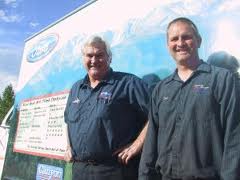 Coloradoans have virtually owned the Stock Car Division. From 1975 through 2006 all winners were local drivers except for Roger Mears, a Californian, who won in 1985. The Vahsholtz family, of Woodland Park, Colorado, has for many years been a major force to be reckoned with. Father and son team, Leonard and Clint, are creeping up on the Unser family total wins, with 31 championship trophies between them. Leonard holds 17 titles in sprint cars, trucks and stock cars. After capturing three pro bike victories on Pikes Peak, Clint has won 15 of the last 16 crowns in the Super Stock division, including the last four.
Coloradoans have virtually owned the Stock Car Division. From 1975 through 2006 all winners were local drivers except for Roger Mears, a Californian, who won in 1985. The Vahsholtz family, of Woodland Park, Colorado, has for many years been a major force to be reckoned with. Father and son team, Leonard and Clint, are creeping up on the Unser family total wins, with 31 championship trophies between them. Leonard holds 17 titles in sprint cars, trucks and stock cars. After capturing three pro bike victories on Pikes Peak, Clint has won 15 of the last 16 crowns in the Super Stock division, including the last four.
Another popular father and son duo were Ralph and Chandler Bruning. Ralph began racing in 1966, and won the stock car division 8 times. His son, Chandler, followed in Ralph’s footsteps in 1991 and entered his first Hill Climb. That year he was named “Rookie of the Year”. Tragically, in 2001 Chandler was killed on Pikes Peak participating in the very event that he and his father loved so much.
The Rally Division was added in 1981, creating great excitement. The Production and Open Rally divisions brought international attention back to Pikes Peak. Production Rally champion John Crawford had an unbroken winning streak from 1982 to 1987, and won again in 1991. The Open Rally Division spawned a number of related divisions and drawn a worldwide field of competitors.
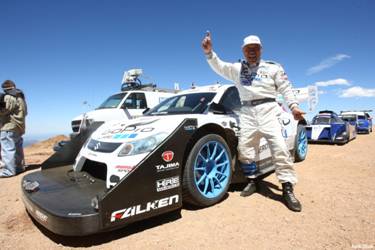 The Millens of New Zealand are another legendary father-son combination that has achieved glory on Pikes Peak. The pair, Rod and Rhys, have won a whopping 15 crowns over the summers competing in Time Attack and Unlimited fields. The Unlimited Division has captured the spotlight in recent years, with Japan’s Nobuhiro Tajima winning the division six consecutive years and breaking the elusive ten-minute barrier in 2011 for the first time with his clocking of 9:51.278. The years have seen many changes on Pikes Peak, including women racers.
The Millens of New Zealand are another legendary father-son combination that has achieved glory on Pikes Peak. The pair, Rod and Rhys, have won a whopping 15 crowns over the summers competing in Time Attack and Unlimited fields. The Unlimited Division has captured the spotlight in recent years, with Japan’s Nobuhiro Tajima winning the division six consecutive years and breaking the elusive ten-minute barrier in 2011 for the first time with his clocking of 9:51.278. The years have seen many changes on Pikes Peak, including women racers.
In 1858 Mrs. Julia Holmes, became the first woman to climb the Peak. The first female driver, Terry Ives, drove a Porsche in the Sports Car Division in 1952. Joyce Thompson entered in 1959; Bonnie McPherson and Marge Stork both drove in 1975. Nancy Reeder, in 1977, piloted a purple and pink racer, and Marie-Alaina Schneider raced in 1984. And, of course, who could forget the first female Division champion Michele Mouton. The “Flying Frenchwoman” drove her Open Rally Audi Sport Quattro to victory in both 1984 and 1985, breaking records in her wake.
In the last twenty years the race has become even more popular with female drivers and racers. Brianne Corn of Amarillo, Texas, became the first woman to triumph on the peak since Mouton last summer when she won the Time Attack 4WD title.
Electric autos are becoming the new sensation on the mountain as well. There are no less than eight entries in the division this year, including Robby and Jeri Unser.
The international popularity of the race is underscored again this year by the presence of competitors from Japan, Hungary, New Zealand, Great Britain, France, Italy, Luxembourg, Australia, Mexico, Germany, the Czech Republic, Russia and Canada.
The Pikes Peak International Hill Climb is the second oldest motorsports race in America and a long-standing tradition in Colorado Springs and the Pikes Peak Region. The race is run on a 12.42 mile (and now fully-paved) course with 156 turns that begins at 9,390 feet and finishes at the 14,110 foot summit of America’s Mountain.
The race is changing rapidly, and its future now without a ceiling. The paving has attracted a roster of dynamic and speedy autos and motorcycles never seen on the Peak before. Records will fall rapidly and global interest is mounting fast.
History has been a teammate of the Pikes Peak International Hill Climb, now in its 90th running in 2012, but the best is ahead.

